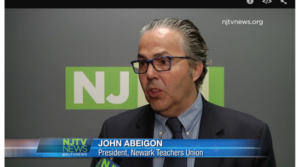Today the State of New Jersey and the Education Law Center presented arguments before the State Supreme Court in the never-ending battle otherwise known as Abbott. (Update here from Star-Ledger.) The question before the Court is whether Gov. Christie’s 2010-2011 school aid cuts of $1.6 billion violated the constitutional mandate to provide a thorough and efficient educations system, regardless of place of residence.
So NJ returns to the timeless question of whether extra money spent on education for poor kids compensates for the deprivations of poverty. More specifically, can a diverse and segregated school system equalize educational opportunity by mandating that cost per pupil for poor kids be equal to the cost per pupil for rich kids?
In other news, the State Fiscal Monitor for one of our Abbott districts, Asbury Park, has just released a report. See NJ Spotlight for full details. This troubled Monmouth County district is plagued by crime and poverty. Per capita income is $13,511 and about 29.3% of families live below poverty level. Enrollment in the public school system has dropped by 35% over the last 10 years. In one of its findings, the Fiscal Monitor reports that cost per pupil in this 2,100-pupil district is $27,000 per kid, which it deems “unreasonably high.” Other details from the report:
- While over the last 12 years student enrollment has declined by 38.8%, over the same period teacher staffing levels declined by 13% and administrative levels by 10%.
- Asbury Park’s student/teacher ration is 8.7 to 1; average for Abbotts is 12 to 1. Student/administrator ratio is 78.3 to 1; average for Abbotts is 141 to 1.
- Asbury Park has a “legal cost per pupil” of $174. No other district comes close to this, averaging about $33 per pupil.
- Three and 4-year old children in Abbott districts qualify for free preschool, managed by the home district. Asbury Park failed to keep accurate attendance records and overpaid providers, one by more that $25K.
- Title 1 school students qualify for after-school services. Asbury Park overpaid providers; the Fiscal Monitor concluded that students were gypped out of 1,900 hours of tutoring from one vendor because of poor oversight of funds.
- Staff members in Asbury Park get 12 paid sick days per year. They also get 3 “critical illness days,” which is for unspecified illnesses of either the employee or a family member and no doctor’s note is required.
- The district pays $400K for telephone services. The Fiscal Monitor found that those costs included 149 phone lines that the district does not use.
Anyway, you get the idea.
How do the kids perform under conditions that strive to compensate for poverty by infusions of money? At Bradley Elementary School 78.6% of 3d graders failed the language arts portion of the state standardized tests. Math is a bright spot: only 38% failed. At Asbury Park Middle School 78.1% of 6th graders failed the language arts portion of the state standardized tests. 67% failed the math portion.
In 2009-2010 at Asbury Park High School 49.5% of kids failed the language arts portion of the High School Proficiency Assessment, an 8th grade level test (though that’s a big improvement from the previous year when 72% failed). 79.6% failed the math portion. 31% of high school seniors graduated by passing the HSPA and 60% had to take an alternative test, given to students who fail the HSPA three times. 50% of white students dropped out. (The stats are better for black and Hispanic students.)
That’s the Abbott remedy. Now the Supreme Court will decide whether it works. Odds are it’ll find for the plaintiffs, ruling that Christie’s statewide budget cuts violated the constitutional rights of the students who attend schools like Asbury Park.
Would those kids have a more equitable education if that $27K per child per year, or annual $61.6 million budget, was spent differently, like as tuition for another school? Our new Interdistrict Public School Choice program is great, but only two districts out of the 57 in Monmouth have applied and both those districts are K-8. There’s one charter school in Asbury Park, Academy Park High School, that limits enrollment to less than 50 kids per grade and has a substantial waiting list.
Most of the kids in Asbury Park are stuck. That’s been true for years, longer than the decades-long Abbott battle that dates back thirty years to 1981. NJ has failed to solve educational inequity through money, though that’s not a fact that is likely to find itself before the Supreme Court justices today.



